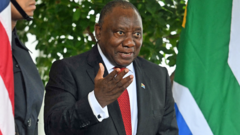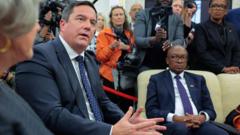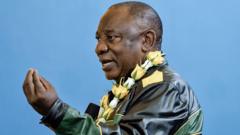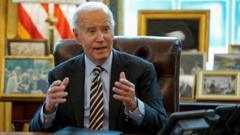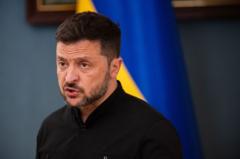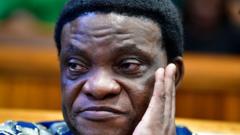During an unexpected diplomatic encounter, US President Donald Trump challenged South African President Cyril Ramaphosa on allegations of “white genocide” in South Africa, notably shifting the conversation to a theatrical display that highlighted his administration's contentious stance on race and land rights.
Trump’s Public Confrontation with Ramaphosa: A Diplomatic Circus
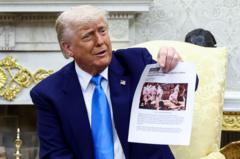
Trump’s Public Confrontation with Ramaphosa: A Diplomatic Circus
In a climactic Oval Office meeting, Trump confronts South Africa's Ramaphosa on controversial issues, leaving a charged atmosphere.
In a dramatic twist of diplomacy, President Trump’s Oval Office meeting with President Cyril Ramaphosa of South Africa morphed into a contentious press spectacle punctuated by accusations of “white genocide” against white farmers. This high-profile event came just three months into Trump’s second term and unfolded under the scrutiny of rolling television cameras, bringing an air of unpredictability characteristic of Trump's tenure in office.
What began as a cordial discussion soon spiraled into an unsettling series of orchestrated provocations. After extending a warm welcome, Trump asked his aides to "turn the lights down" and dimmed the atmosphere, exposing Ramaphosa to a flashing screen filled with images intended to illustrate Trump's claims about white South Africans being "persecuted."
A notable figure present during this charged encounter was Elon Musk, the South African-born billionaire, who observed the proceedings quietly from the sidelines. Trump showcased footage of South African political leaders—a move echoing his earlier encounters with foreign heads of state—highlighting the increasingly tense narrative surrounding the treatment of Afrikaners.
While Ramaphosa attempted to refute Trump's dangerous assertions by emphasizing the necessity to listen to the voices of South Africans—particularly against a backdrop of divisive rhetoric—Trump reiterated his contentious views and pressed the South African leader about the "persecution" of white farmers; however, Ramaphosa maintained his composure and criticized the claims.
In a strategic maneuver, Ramaphosa brought notable South African golfers, including Ernie Els and Retief Goosen, to the meeting, perhaps attempting to shield himself from Trump’s aggressive assertions. Their presence alongside Ramaphosa symbolized an effort to portray a united front amidst the scrutiny of the conversation and highlighted the absurdity of suggesting a genocide of wealthy farmers when affluent representatives of that demographic were present.
Though Trump praised the golfers' insights on agriculture, Ramaphosa's retorts were deliberate and measured, suggesting that if a dire situation truly existed for Afrikaner farmers, these prominent figures would not be attending such gatherings. The tension saw Ramaphosa skillfully navigate Trump's provocations, leaving the US president to focus his remarks more toward his own political audience rather than achieving any substantial diplomatic breakthroughs.
As the meeting came to a close, the ongoing complexity of Trump's performative diplomacy was unmistakably evident. His approach not only aimed to serve constituency interests at home but also exposed the fragility of international engagements conducted under such public scrutiny. The pertinent question that lingered in the air was whether this encounter would shape future relations between the US and South Africa or merely serve as another episode within Trump’s reality-show-style presidency.
What began as a cordial discussion soon spiraled into an unsettling series of orchestrated provocations. After extending a warm welcome, Trump asked his aides to "turn the lights down" and dimmed the atmosphere, exposing Ramaphosa to a flashing screen filled with images intended to illustrate Trump's claims about white South Africans being "persecuted."
A notable figure present during this charged encounter was Elon Musk, the South African-born billionaire, who observed the proceedings quietly from the sidelines. Trump showcased footage of South African political leaders—a move echoing his earlier encounters with foreign heads of state—highlighting the increasingly tense narrative surrounding the treatment of Afrikaners.
While Ramaphosa attempted to refute Trump's dangerous assertions by emphasizing the necessity to listen to the voices of South Africans—particularly against a backdrop of divisive rhetoric—Trump reiterated his contentious views and pressed the South African leader about the "persecution" of white farmers; however, Ramaphosa maintained his composure and criticized the claims.
In a strategic maneuver, Ramaphosa brought notable South African golfers, including Ernie Els and Retief Goosen, to the meeting, perhaps attempting to shield himself from Trump’s aggressive assertions. Their presence alongside Ramaphosa symbolized an effort to portray a united front amidst the scrutiny of the conversation and highlighted the absurdity of suggesting a genocide of wealthy farmers when affluent representatives of that demographic were present.
Though Trump praised the golfers' insights on agriculture, Ramaphosa's retorts were deliberate and measured, suggesting that if a dire situation truly existed for Afrikaner farmers, these prominent figures would not be attending such gatherings. The tension saw Ramaphosa skillfully navigate Trump's provocations, leaving the US president to focus his remarks more toward his own political audience rather than achieving any substantial diplomatic breakthroughs.
As the meeting came to a close, the ongoing complexity of Trump's performative diplomacy was unmistakably evident. His approach not only aimed to serve constituency interests at home but also exposed the fragility of international engagements conducted under such public scrutiny. The pertinent question that lingered in the air was whether this encounter would shape future relations between the US and South Africa or merely serve as another episode within Trump’s reality-show-style presidency.





